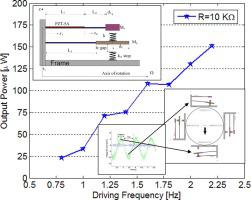Mechanical Systems and Signal Processing ( IF 7.9 ) Pub Date : 2021-12-18 , DOI: 10.1016/j.ymssp.2021.108737 M. Febbo 1 , S.P. Machado 2

|
We propose a novel frequency-up converting device in an extremely low frequency rotating scenario based on a multi-beam piezoelectric energy harvester and multiple impacts. The rotating multi-beam structure consists of a piezoelectric sheet added to a top beam, a large seismic mass added to a bottom beam and an elastic stop which can be eventually replaced by a buzzer. At half of the rotating cycle, the bottom beam impacts the top beam by means of a spring generating energy by a frequency up-conversion mechanism. At the other half of the cycle, the up and bottom beam separate from each other and the bottom beam impacts an elastic stop or a buzzer which are used to simultaneously recover the kinetic energy of the collision, generate energy (buzzer) and prevent possible damage to the structure. An analytical model that governs the electromechanical equations and the impact dynamics is proposed to provide a means to predict the generated output energy. The model is based on the Euler-Bernoulli structural theory for the beams and a piezoelectric nonlinear constitutive model. Two different energy generation possibilities are studied, depending on the selection of the elastic stop or the buzzer. When the elastic spring acts as stop, the collision between the bottom beam and the stop is more elastic. Replacing the spring stop with a piezo buzzer adds to the system an additional mechanism of energy conversion. By making several experimental tests, the analytical model is validated by computing the cumulated energy. The results demonstrate that the buzzer element significantly improves the harvested power when it replaces the elastic stop. To estimate the usable power of the device, rectifier circuits coupled to the piezo elements are built and test. The results show that in the case of the buzzer used as a stop, a rectified power that overcomes 6.4 times in average other previous designs is harvested in the range of 0.8–2.2 Hz over an electrical load of 10 kΩ. The amount of collected power is suitable for autonomous sensing of wind turbines of 30 kW with rotational speeds of between 50 and 150 rpm.
中文翻译:

极低频场景下具有上转换机制的旋转多光束能量采集器
我们提出了一种基于多光束压电能量收集器和多重冲击的极低频旋转场景中的新型升频转换装置。旋转多梁结构由加在顶梁上的压电片、加在底梁上的大地震质量和最终可由蜂鸣器代替的弹性挡块组成。在旋转周期的一半时,底梁通过上变频机构产生能量的弹簧撞击顶梁。在循环的另一半,上下梁相互分离,下梁撞击弹性挡块或蜂鸣器,用于同时回收碰撞动能,产生能量(蜂鸣器)并防止可能的损坏到结构。提出了一种控制机电方程和冲击动力学的分析模型,以提供一种预测产生的输出能量的方法。该模型基于梁的 Euler-Bernoulli 结构理论和压电非线性本构模型。根据弹性挡块或蜂鸣器的选择,研究了两种不同的能量产生可能性。当弹性弹簧作为挡块时,底梁与挡块之间的碰撞更有弹性。用压电蜂鸣器代替弹簧挡块为系统增加了额外的能量转换机制。通过进行多次实验测试,通过计算累积能量来验证分析模型。结果表明,当蜂鸣器元件取代弹性挡块时,它显着提高了收集的功率。为了估计设备的可用功率,构建和测试耦合到压电元件的整流器电路。结果表明,在蜂鸣器用作停止器的情况下,在 0.8-2.2 Hz 的范围内在 10 kΩ 的电气负载上获得了比其他先前设计平均 6.4 倍的整流功率。收集的功率量适用于转速为 50 至 150 rpm 的 30 kW 风力涡轮机的自主感应。


















































 京公网安备 11010802027423号
京公网安备 11010802027423号